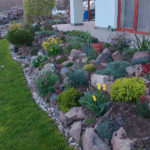Are you looking to create a beautiful and functional space with a layout edible garden design? Designing an edible garden goes beyond just planting fruits, vegetables, and herbs. It involves careful consideration of factors such as location, layout, plant selection, companion planting, aesthetics, and maintenance. In this article, we will explore the importance of edible garden design and provide valuable insights on how to plan and maintain a successful edible garden.
When it comes to designing an edible garden, selecting the perfect location is crucial. Factors such as sunlight, shade, and soil quality can significantly impact the success of your garden. We will discuss how to assess these considerations and choose the best location for your edible garden.
Once you have determined the ideal location for your garden, planning the layout becomes essential. Whether you opt for raised beds, container gardens, or in-ground planting, each option has its benefits and drawbacks. We will delve into the different options available and help you select the most suitable layout for your needs.
Selecting the Perfect Location for Your Edible Garden
When it comes to creating a successful edible garden, one of the most important factors to consider is the location. Whether you have a large backyard or a small balcony, ensuring that your plants receive the right amount of sun, shade, and quality soil is essential for their growth and productivity.
The Importance of Sun Exposure
Before deciding on the location for your edible garden, it’s crucial to understand the sunlight requirements of different plants. Most vegetables, herbs, and fruits thrive in full sun, which means they need at least 6-8 hours of direct sunlight each day. However, some plants can tolerate partial shade or even prefer it. Take note of how the sun moves across your outdoor space throughout the day to identify areas with the best sun exposure for your garden.
Soil Quality and Drainage
Another key consideration when selecting a location for your edible garden is the quality of the soil and its drainage. Soil that is well-draining and nutrient-rich will provide an ideal growing environment for your plants. Conduct a simple soil test to determine its pH level and composition.
Additionally, assess the area’s drainage by observing how water accumulates after rainfall or irrigation. If necessary, amend the soil with organic matter such as compost or vermiculite to improve its structure and fertility.
Working With Shade
If you have limited options for sunny spots in your outdoor area, don’t worry – there are plenty of edible plants that can thrive in partial shade conditions. Leafy greens like lettuce and spinach, as well as herbs like mint and parsley, are examples of edibles that can do well with less sunlight. Embracing shade-tolerant varieties opens up more possibilities for where you can create your edible garden while still yielding a bountiful harvest.
By carefully considering sun exposure, soil quality, and embracing shade-friendly options, you can select the perfect location for your edible garden that will set it up for success from the start.
Planning the Layout of Your Edible Garden
When planning the layout of your edible garden, there are several options to consider, each with its own set of advantages. One popular choice is raised beds, which offer better drainage and soil quality compared to traditional in-ground planting. Raised beds also provide better control over the soil composition, making it easier to create optimal growing conditions for your plants. Additionally, they can help keep out weeds and pests, and make gardening more accessible for individuals with mobility issues.
Container gardens are another great option for those with limited space or poor soil quality. This method allows you to grow a variety of vegetables, herbs, and fruits in pots or other containers on a deck, patio, or balcony. Container gardens can also be easily moved around to take advantage of sunlight or protect plants from harsh weather conditions.
If you have ample space and good soil quality in your yard, in-ground planting may be the most practical option for your edible garden. This method allows for the natural spread of plant roots and provides them with access to nutrients deep within the ground. However, proper spacing and organization are crucial when planting directly into the ground to ensure that your plants receive enough sunlight and water.
Ultimately, the best layout for your edible garden will depend on factors such as available space, sunlight exposure, soil quality, and personal preference. It’s important to assess these variables before deciding on a specific layout in order to create a successful and bountiful garden.
Choosing the Right Vegetables, Herbs, and Fruits for Your Edible Garden
When it comes to choosing the right vegetables, herbs, and fruits for your edible garden, there are a few factors to consider. Not only do you want to select plants that you enjoy eating, but you also need to take into account the climate and growing conditions in your area. Here are some tips for choosing the best produce for your edible garden:
- Consider your climate: Different vegetables, herbs, and fruits thrive in different climates. For example, if you live in a cooler climate, you may want to focus on growing leafy greens like lettuce and kale, as well as root vegetables like carrots and radishes. In warmer climates, you may have success with tomatoes, peppers, and herbs like basil and oregano.
- Think about space: Some plants require more space to grow than others. If you have limited space in your garden, consider planting compact or bush varieties of vegetables and fruits. Alternatively, you can opt for vertical gardening techniques or container gardening for herbs and smaller fruit varieties.
- Consider what you enjoy eating: Ultimately, the goal of an edible garden is to grow produce that you will enjoy eating. Think about your favorite vegetables and fruits when planning your garden layout. Additionally, consider incorporating herbs that you frequently use in cooking or for medicinal purposes.
By carefully considering these factors and doing some research on plant varieties that will thrive in your area, you can ensure a successful harvest from your edible garden.
Remember to also leave some room for experimenting with new plant varieties each season. Trying out different types of produce can be an enjoyable part of gardening and may lead to discovering new favorites that thrive in your specific growing conditions.
Companion Planting and Crop Rotation
Understanding Companion Planting
Companion planting involves planting different types of plants next to each other in order to benefit one another. Some plants can improve the flavor and growth of their companions, while others can help repel pests. For example, planting marigolds alongside tomatoes can help repel nematodes, while planting basil near tomatoes can improve their flavor.
Maximizing Yield Through Strategic Pairings
By strategically selecting companion plants, you can maximize your garden’s yield. Some popular combinations include planting carrots with onions, as the smell of onions can deter carrot fly, or growing beans alongside corn to provide support for climbing beans while the beans fix nitrogen in the soil that benefits the corn.
Crop Rotation: Promoting Soil Health and Minimizing Pests
The Importance of Crop Rotation
Crop rotation involves moving crops around within a garden or field each year to prevent the buildup of pests and diseases in the soil. Each plant has different nutrient needs, so rotating crops helps maintain soil fertility and decrease soil-borne diseases.
Implementing a Crop Rotation Plan
Developing a crop rotation plan involves dividing your edible garden into sections (or using raised beds) and rotating crops based on their category (e.g. legumes, brassicas, root vegetables). By following a structured crop rotation plan, you can reduce pest and disease pressure while improving overall soil health.
By incorporating companion planting and crop rotation strategies into your edible garden design, you not only maximize the productivity of your garden but also create a more sustainable and eco-friendly growing environment. These methods have been used for centuries by farmers and gardeners alike to promote healthy plant growth and minimize pest problems without relying on chemical interventions.
Incorporating Aesthetics Into Edible Garden Design
When planning the layout of your edible garden, it’s important to consider not only the practical aspects but also the aesthetic elements. An aesthetically pleasing garden can enhance your outdoor living space and provide a beautiful environment for growing fruits, vegetables, and herbs.
One way to incorporate aesthetics into your edible garden design is by creating defined pathways and borders using natural materials such as gravel, stone, or wood. These elements can help to separate different areas of the garden while adding visual interest.
Another key aspect of incorporating aesthetics into edible garden design is choosing the right combination of plants to create an attractive and harmonious display. Consider using a variety of colors, textures, and heights when selecting vegetables, herbs, and fruits for your garden. This diversity can not only make your garden visually appealing but also help with pest control and pollination.
To further enhance the aesthetics of your edible garden, consider adding decorative elements such as trellises, arbors, or other structures that can support climbing plants or provide focal points in the garden. Additionally, incorporating seating areas or outdoor dining spaces within the garden can make it a more inviting place to spend time in and enjoy the beauty of your homegrown produce.
Overall, creating a beautiful and functional space for your edible garden involves thoughtful planning and attention to detail. By considering both practical and aesthetic elements in the layout of your garden, you can achieve a well-balanced design that enhances both the visual appeal and productivity of your space.
| Aesthetic Elements | Examples |
|---|---|
| Defined pathways | Gravel, stone, or wood borders |
| Plant selection | Variety of colors, textures, and heights |
| Decorative elements | Trellises, arbors, seating areas |
Maintenance and Care Tips for Your Edible Garden
Maintaining an edible garden requires consistent care to ensure healthy and bountiful harvests. Watering is a crucial aspect of garden maintenance, especially during the warmer months. It’s essential to water your plants deeply and less frequently to encourage deep root growth, which makes them more resilient during dry periods. The frequency of watering will depend on the type of soil, weather conditions, and the specific needs of the plants in your edible garden.
Fertilizing is another key component of caring for your edible garden. Organic fertilizers are recommended as they provide essential nutrients to the soil and improve overall soil health. Compost, aged manure, and organic liquid fertilizers are great options to consider. Fertilize your plants according to their individual needs and be mindful not to over-fertilize, as this can lead to nutrient imbalances in the soil.
Pest control is necessary to protect your edible garden from unwanted insects and critters that can damage or destroy your crops. There are various eco-friendly pest control methods you can employ, such as companion planting, using natural predators like ladybugs or praying mantises, and creating physical barriers like row covers or netting. Regularly inspecting your plants for signs of pests or disease can help you address issues early on and prevent them from spreading throughout the garden.
| Edible Garden Care | Tips |
|---|---|
| Watering | Water deeply and less frequently; adjust frequency based on plant needs |
| Fertilizing | Use organic fertilizers; avoid over-fertilization; tailor fertilization to plant requirements |
| Pest Control | Employ eco-friendly methods; inspect plants regularly for pests or disease |
Harvesting and Enjoying the Fruits of Your Labor
Once you have put in the hard work of planning and maintaining your edible garden, it’s time to enjoy the fruits of your labor. Harvesting and using your homegrown produce can be incredibly rewarding, and preserving your bounty allows you to enjoy it for months to come. Here are some tips for making the most of your harvest:
- Harvest at the Right Time: Different fruits, vegetables, and herbs have different optimal harvest times. Be sure to research the best time to pick each item in your garden to ensure peak flavor and freshness.
- Utilize Your Harvest: Once you’ve harvested your homegrown produce, get creative with how you use it. Try new recipes that highlight the flavor of your freshly picked fruits and veggies, or consider making homemade preserves, salsas, or pickles.
- Explore Preservation Methods: There are many ways to preserve your harvest for later use. Consider canning, drying, freezing, or pickling your produce to extend its shelf life. Each method offers a unique way to enjoy your homegrown goodies throughout the year.
Enjoying the literal fruits (and vegetables) of your labor from an edible garden is a fulfilling experience that brings joy and satisfaction. By following these tips for using and preserving your homegrown produce, you can make sure that all your hard work pays off long after harvest season has ended.
Remember – embracing the benefits of a well-planned edible garden design extends beyond just the act of gardening itself; it includes enjoying the delicious results as well.
Conclusion
In conclusion, designing and planning an edible garden can be a rewarding and beneficial endeavor for any gardener. By carefully considering the layout, location, plant selection, and maintenance of your edible garden, you can enjoy a bountiful harvest of fresh fruits, vegetables, and herbs while creating a beautiful and functional outdoor space.
Embracing the benefits of a well-planned edible garden design not only provides you with delicious homegrown produce but also allows you to connect with nature and improve your overall well-being.
A well-planned edible garden design can also contribute to sustainable living by reducing your carbon footprint through the production of locally grown food. By growing your own fruits and vegetables, you can decrease the need for transportation-related emissions associated with store-bought produce. Additionally, embracing edible garden design encourages environmental stewardship by promoting biodiversity in your own backyard through companion planting and crop rotation techniques.
Frequently Asked Questions
How Do You Plan an Edible Garden?
Planning an edible garden involves determining the location, considering the sunlight and soil conditions, and choosing the right plants to grow based on your climate and space available.
It’s important to start by creating a layout or design for your garden, selecting the types of vegetables, fruits, herbs, or other edible plants you want to grow, and considering their spacing and companionship within the garden.
How Do You Landscape Edible Plants?
Landscaping edible plants involves integrating them into your overall garden design in a visually appealing and functional way. This can be done by incorporating raised beds, vertical gardening structures, or planting in containers.
Additionally, intermixing edible plants with ornamental ones can create a beautiful landscape while also providing fresh produce. Proper maintenance is essential to keep the landscape looking tidy as these plants grow.
How Do I Make a Garden Layout Plan?
Making a garden layout plan involves sketching out your gardening area and considering factors such as sun exposure, soil type, water access, and any existing flora or structures. Start by plotting out where you want each plant to go based on its sunlight requirements and potential height/width at maturity.
Consider aspects like walkways and access points as well. Creating a detailed plan will help maximize space and ensure that each plant has room to thrive while making it easier for you to maintain the garden over time.

Welcome to my gardening blog! I am passionate about plants and enjoy sharing my knowledge and experiences with others. In this blog, I will write about everything related to gardening, from tips on how to get started to updates on my own garden projects.





